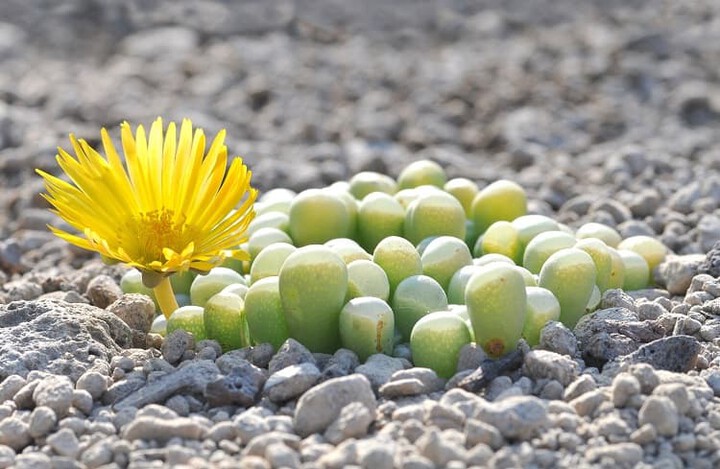The Fenestraria is native to Coastal South Africa and is tolerant of warmer conditions, doing especially well in extreme heat.
When you have one at home, it’s best to place it somewhere there’s full sun for the entire day, but if you’re only able to find a spot with six hours of direct sun, it will still thrive.
For indoor baby toes succulents, you’ll want to keep it in as much bright but indirect light as possible.
As with most succulents, you’ll want a well-draining soil for the best chance of a healthy baby toes.
The pot that it’s housed in should allow for proper drainage as well, so if it’s not set up for this, you can easily drill a few holes in the bottom that prevent the roots from staying moist and developing conditions like root rot.
The best temperature for the Fenestraria is warmer conditions, and it’s not known as a cold-hardy plant.
You’ll want to ensure its environment never gets below 20 degrees Fahrenheit to keep it healthy.
If you live somewhere the temperature dips lower than this, keeping them indoors but in a well-lit area can keep them warm enough to survive, even in the colder months.
Flowering Baby Toes Succulents
The baby toes is a flowering succulent and if you’re lucky enough to own one you’ll spot them growing flowers during late summer through early spring, although they won’t produce any fragrance.
There are two main types of baby toes succulent, and depending on which one you have, you’ll get to witness a unique blossoming effect.
The Fenestraria Aurantiaca will produce daisy-like flowers that are orange colored and grow to be around three inches.
They’ll be a lot wider than the leaves of the plant, and will spread out to take over most of the succulent.
If you have a Fenestraria Rhopalophylla, the leaves will be small and white, and the leaves will have a harsher blunt tip compared to the softer round shape.
The Perfect Growing Conditions

Known as one of the easiest plants to care for, there’s very little you have to do once you have the right position for your Fenestraria.
To ensure your plant grows as large and healthy as possible, you’ll want to make sure it’s potted correctly, has the right soil, and is watered on a set schedule.
How Often Should They Be Watered?
If you’re someone who forgets to water their plants often, the Fenestraria is a good choice.
These plants can handle drought conditions and usually won’t die off fast without water but you should keep up an active watering schedule where possible.
During their growth phase, water them regularly so that the soil has enough time to dry out in between without getting too arid, and ease off the watering during summer.
The Best Pots For Optimal Growth
Succulents are prone to rotting and dying when they’re overwatered, and if there’s a lot of water sitting in the bottom of the pot this is disastrous for them as well.
The best pot is one that allows for drainage so the water runs through the soil and the plant roots and then out through the bottom, so make sure you choose one with at least one hole.
Choosing The Right Soil
The baby toes succulent is like most other succulents in that it needs a soil that drains well.
This means choosing either a sandy or calciferous soil to put into the pot, or even making up your own potting mixture.
This can be done with a standard potting soil mixed with fertilizer, and then with pumice stones mixed through it.